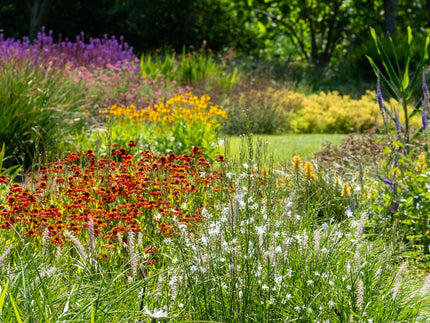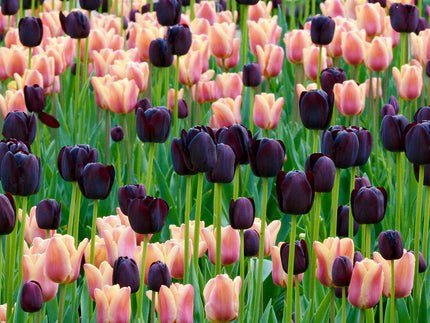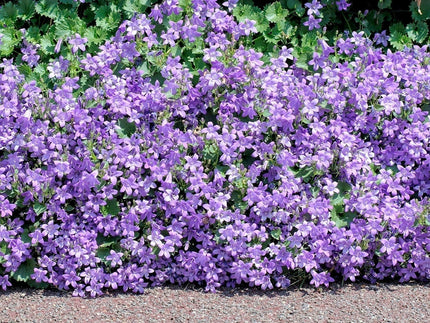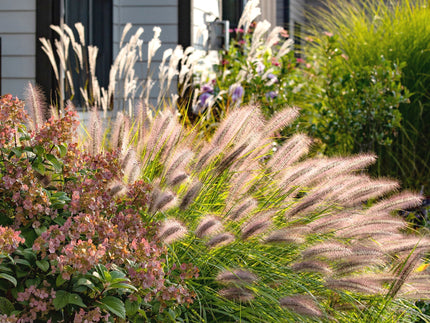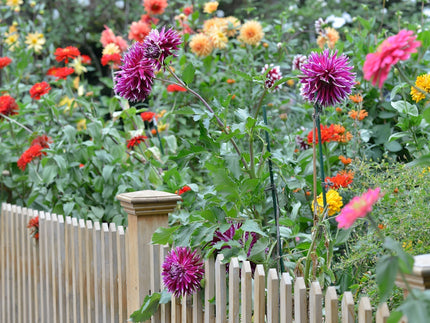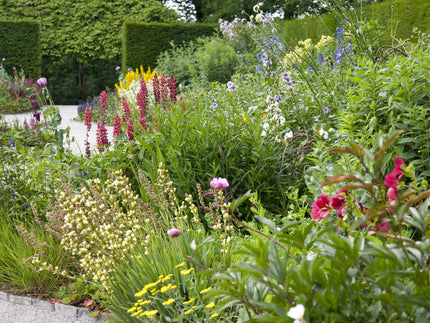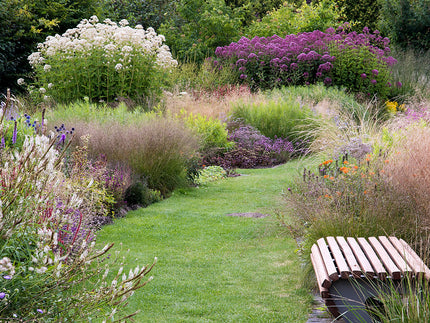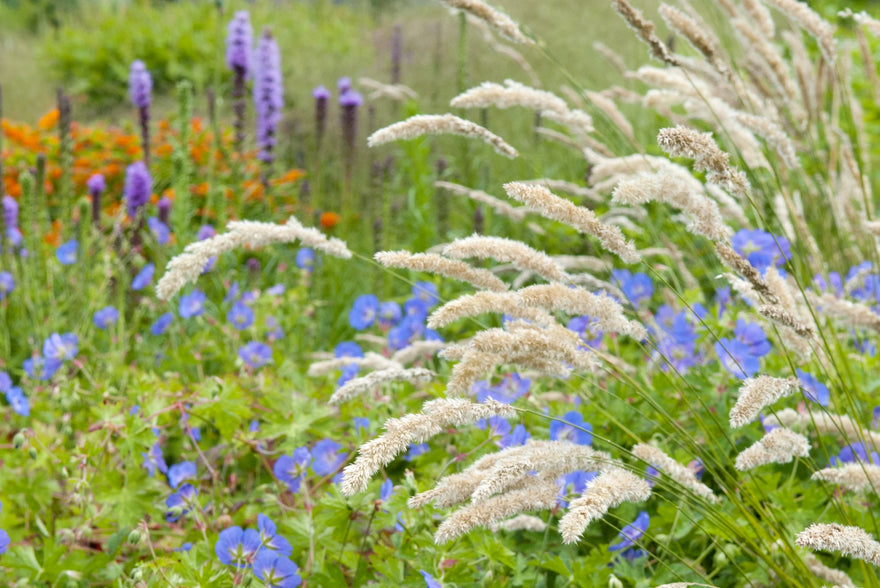
Top tips and plants for clay soil gardens
If you garden on a heavy clay soil then you’ll already know that it can be hard work with. There are certain challenges associated with clay soil, such as its habit of becoming rock hard when it dries out in summer, or sticky, compacted and waterlogged in winter. But there are many positives to gardening on clay soil if it is managed with care, and plenty of plants which will thrive in this soil type.
All about clay soil
To get the best from clay soil, it’s worth understanding what gives clay its characteristics. Before we get onto plants, we’re going to get scientific about soil...
Properties of clay soil
Clay particles are flat in shape with a diameter of less than 0.002mm. By comparison a sandy soil has much larger particles of 0.02 to 2mm with a more rounded shape and larger spaces between each particle. This allows water to pass freely between the gaps making sandy soils free draining, and prone to drought. In contrast, clay soil particles are smaller and flatter, which allows for less space between each particle for the movement of air and water. Therefore, a clay soil retains more moisture because water finds it harder to drain between such tiny gaps. Being a wetter soil, clay is also slower to warm up in spring which can mean that plants take a little longer to start into growth.
The flat shape of the particles also means that the soil can also become compacted much more easily. In fact, this type of soil will even retain its shape if you try to mould a small quantity in your hand. Once the soil becomes compacted, oxygen finds it harder to penetrate the soil and carbon dioxide can struggle to escape. The density of it makes growing conditions quite challenging for plant roots.
An interesting and lesser-known characteristic of clay is that the particles have a positive electrical charge which attracts water, much like when two magnets are pulled together. It is more difficult for plant roots to draw water away from this attraction and access the moisture, even when plenty is available!
Pros and cons of clay soil
- If you have clay soil you’ll know that the dense and heavy structure makes it much harder to dig. In wet weather, waterlogged clay becomes sticky and unworkable and is easily compacted, even by simply digging or stepping on it.
- Very dry conditions can cause compacted clay to become so hard you’d need a mattock to break it up. Once compacted, the soil cannot drain easily, and oxygen is unable to penetrate the ground, while carbon dioxide becomes trapped.
- Moving swiftly on to the benefits of clay soil, you’ll find that its water retentive nature means you’ll be watering less frequently than gardening friends who are on sandy soil, which drains so freely that it can become dust-like in summer even with daily watering. In times of drought, your clay soil (although difficult to dig) can be a little less damaging for your plants.
- Clay also retains nutrients particularly well, so the soil is likely to be fertile with plenty of available minerals to feed your plants.
- Clay naturally shrinks and swells throughout the year depending on its water content. Winter frosts will naturally break-up the clay particles through the process of freezing and thawing, which means you can allow it to naturally cultivate itself to some extent.
- Do you enjoy the physical health benefits of gardening? Here’s a benefit for you! Due to the fact that clay soil can be heavy work, planting and weeding in your borders is excellent exercise and will certainly build your muscles up!
- There are very many beautiful and low-maintenance plants which thrive in clay soils, which gives you plenty of options when deciding on your planting scheme. We’ll get on to plant choices later in this article.
How to garden on clay soil
Improving clay soil
Improving the consistency of clay soil is a gradual process and can take some years and quite a lot of digging, but it’s very worthwhile. The aim is to hang on to the benefits of clay, whilst making the texture it a little easier to work with. The best time to set about improving clay soil is late autumn and early spring. Avoid working on clay soil during winter because that is when it will be at its wettest, most difficult to dig and easily compacted. Likewise, avoid this job in summer when the soil is dry and hard.
The first step is dig over the area to a spade’s depth, breaking up any clumps as you go. This process reduces compaction and improves the texture. Secondly, pile on a thick layer of mulch, such as leaf mould or compost, and then dig that in to the existing soil.
Incorporating plenty of organic matter (mulch, well-rotted manure, compost) can help to loosen up clay soil. If done repeatedly in late autumn and/or early spring each year, it will steadily improve drainage and texture. It’s tempting to add sand or grit to aid drainage, but this is very heavy work and unless you use a huge quantity, it will make very little difference to the overall composition of the soil. The addition of organic matter is far more feasible and effective.
If you also have patio pots for summer and spring bedding or bulbs, empty the old compost from the pot onto your borders at the end of the season. It’s only a little but it will help with texture and it’s also a good use of old compost.
Planting in clay soil
Plan to undertake any planting between March and the end of May, once the soil is less soggy after winter and before the ground becomes hard again in summer. You can also plant in autumn – typically between September and late November is a good time. After you have dug a hole for planting, include some compost to the bottom of the planting hole so that the new roots can easily start to grow. When the soil is wet, you can lay out a plank of wood to stand on whilst planting, this spreads your weight across a wider area and reduces compaction.
Maintaining clay soil
Dig out weeds as and when you see them while they’re still small and before they drop seed. If you allow weeds to flower, you will soon find that you have far more weeds growing from the seeds they dispersed. Also, the roots will be easier to remove entirely before they become large and burrow deep into the clay.
Where planting schemes are well established, you can apply an annual mulch of well-rotted organic matter in autumn or spring. Provide a generous blanket of mulch to a depth of 5-8cm. This will help protect it from moisture loss over summer and provide valuable nutrients as the mulch decomposes. As a bonus, it also helps to improve soil texture and suppress weed growth.
Plants for clay soil
Choosing the right plants for clay soil is essential for a successful planting scheme. Although some effort to improve the soil will certainly increase the range of plants that can be grown, it’s always best to select plants that will enjoy these growing conditions rather than trying to amend the conditions to suit the plant.
Clay soil can support many beautiful plant types. With careful selection, you can grow plants that will positively flourish, blossoming into a fabulous well stocked garden that you can feel proud of. Whether you’re looking for suitable plants to grow in sun or shade, or to flower in spring or summer, you can discover the range available by following the links below.

Summer-flowering plants for sunny areas with clay soil:
These plants will enjoy a position that receives sun for at least 6 hours a day. However, many are quite versatile so you will also see some of them listed as being suitable for a partially shaded area with clay soil as well.
- If you’ve a taste for the tropics, try exotic cannas to bring sizzle to summer borders. These half-hardy rhizomes will need to be lifted and stored over the winter months but can be replanted the following spring. Heliopsis makes an excellent planting partner, with blooms that glow as bright as the sun itself!
- To create a wildlife paradise, choose nectar-rich hardy perennials like hardy Geranium, Monarda and Achillea whose flowerheads attract pollinating insects to the garden.
- For a calming oasis of swaying grasses choose tactile Panicum and Carex 'Evergold'. Mingled with a veil of floaty Verbena bonariensis, they bring a peaceful serenity to your outdoor space.
View the full range of summer-flowering plants for a combination of full sun/part shade and clay soil.

Summer-flowering plants for shade with clay soil:
These plants demand less sun, coping well in locations which receive lower light levels. They are suitable for areas in partial shade (receiving less than 6 hours of direct sun per day), and some even prefer those cool, dark borders in dappled or full shade.
- Astilbe will certainly appreciate some protection from direct sun, which can scorch its delicate ferny foliage. In return, it delivers feathery plumes of flowers throughout the summer, which make fabulous cut flowers!
- No shaded corner would be complete without the leafy presence of hostas. It’s hard to pick just one from the many different varieties, each boasting its own uniquely patterned and textured foliage. Plant a few together for a vibrant patchwork of ground-cover.
- Try the heart-shaped leaves of Brunnera for alternative ground-cover in woodland gardens—the flowers are loved by pollinating insects. You could team them up with the fuzzy blooms of Eupatorium to provide a valuable buffet for visiting bees and butterflies.
View the full range of summer-flowering plants for a combination of shade and clay soil.

Spring-flowering plants for sunny area with clay soil:
Spring brings longer days, and warmer weather! A clay soil can take a little longer to warm up so you’ll find that the earliest bulbs start into growth slightly later than gardens with lighter soils.
- For a splash of early colour, plant a swathe of Crocus bulbs in open, sunny areas to pop up through lawns and the front of borders.
- If you adore the colour of tulips in spring, stick to botanical Tulip varieties which cope better on heavier soils. As tulips are not typically tolerant of heavy clay soils, it is best to include grit and compost when planting them.
- Few bulbs are quite so well suited to clay soils as Camassia. This bulb will emerge in late spring, filling the colour gap between spring bulbs and summer perennials. It’s equally happy in a shaded spot too.
- For plant connoisseurs who like something a little different, try Leucojum. Although not commonly grown in gardens, this elegant spring bulb is low maintenance and flourishes in damp, clay soil.
View the full range of spring-flowering plants for a combination of full sun/partial shade and clay soil.

Spring-flowering plants for shade with clay soil:
Spring bulbs can be particularly useful where a canopy of deciduous trees creates shade in summer. In spring before tree leaves appear, the bare branches allow a little extra light to reach ground level so that spring bulbs can flourish.
- Eranthis hyemalis and Crocus will happily grow in shade, forming spreading ground cover as they establish which is perfect for carpeting woodland gardens. For a succession of colour, mingle them with bluebells which appear later in spring.
- Of course, no spring garden is complete without a crowd of cheery daffodils brighten the dullest day. Narcissus are incredibly versatile bulbs, coping well in almost any soil and happily tolerate light or dappled shade, so you can rely on these beauties in a shaded clay soil border.
- A dainty and unusual addition for a clay soil area in dappled or full shade is Erythronium (dog’s tooth violet). They enjoy a moist, clay-based soil and thrive in the most dimly-lit areas of the garden, such as woodland areas or containers in a shaded corner.
View the full range of spring-flowering plants for a combination of full shade/partial shade and clay soil.





















































































